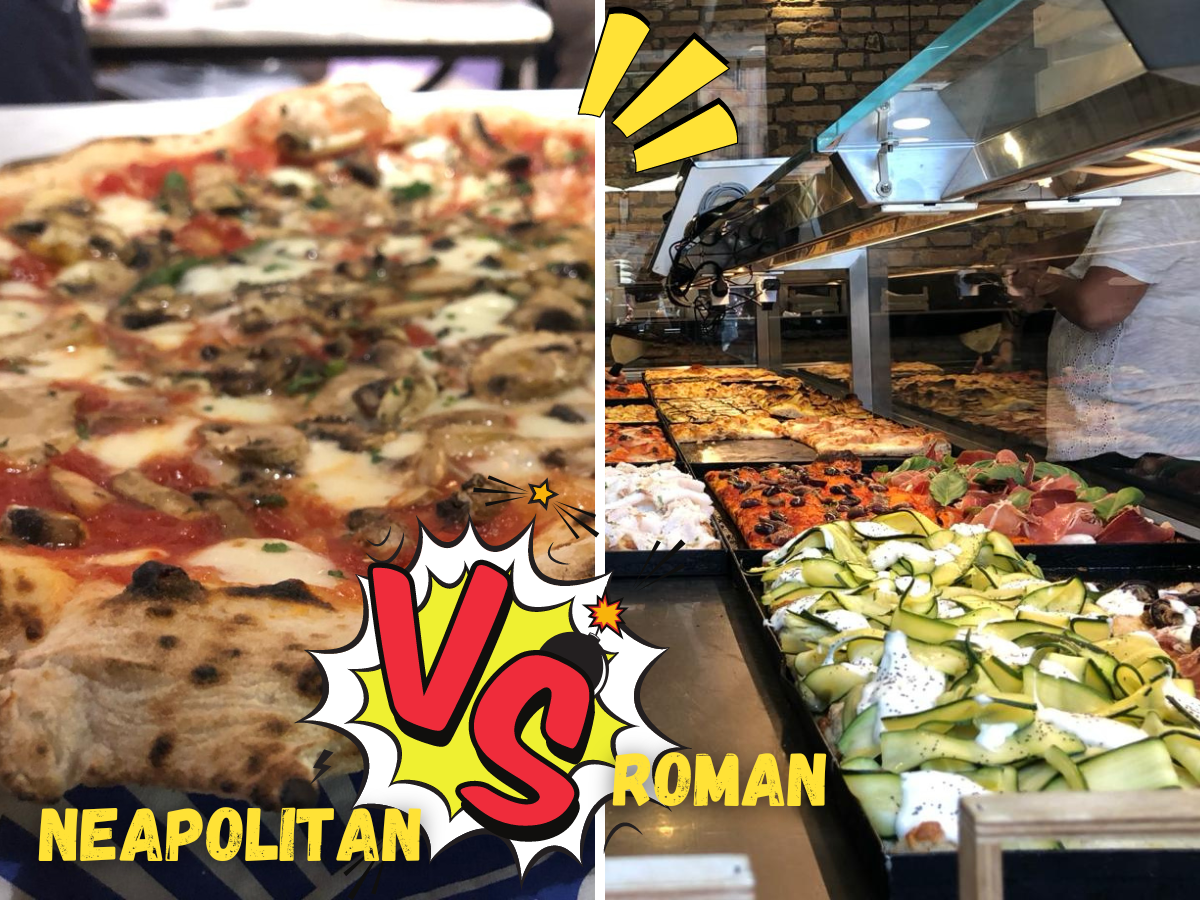History is filled with match-ups that pit one beloved thing against another. Think Ali vs. Frazier, The Beatles vs. The Rolling Stones, McDonald’s vs. Burger King. There’s one rivalry that’s often overlooked: Neapolitan pizza vs. Roman pizza. That is, the pizza styles favored in Naples and Rome, Italy. Many people out there might not even consider this a rivalry in the classic sense. After all, one can love both styles of pizza equally. Pizza is pizza, after all.
Growing up in the Chicago area, my pizza intake consisted of Chuck E. Cheese pies, Sunday night Chicago-style deep dish, and the occasional lazy weeknight frozen option. This began to gradually shift as I entered adulthood, though not by much (deep dish will never be out of vogue). I began to realize that there was a world of pizza beyond mediocre American chains and deep dish. Before conquering the globe, pizza developed regional styles in Italy over centuries. Goodbye frozen DiGiorno, hello pizza al taglio.
Pizza is one of the most cherished foods on the planet. From the alleyways of Naples to a modern suburban mall in middle America, pizza is one of the only common threads connecting all of humanity. As such, it inspires fiery passions, ignites fierce debates, and fosters deep loyalty. Neapolitan pizza (the style native to Naples, Italy) and Roman pizza (the Italian capital’s preferred style) are undoubtedly two of Earth’s best. Let’s dive deeper into these cheesy, doughy slices of heaven.

Thank You, Queen Margherita
In the middle of Naples’ graffiti-covered Via dei Tribunali sits an iconic restaurant serving up Neapolitan pizza: Gino e Toto Sorbillo. It was our first day in Naples and Avia and I were starving. It was late in the afternoon and we had spent the day walking around the city, taking in art galleries, museums, and of course, churches. With great difficulty, we controlled our food intake in order to leave room for the main event – Neapolitan pizza.
There is no definitive story for how this very distinctive pizza came to Naples. But first, let’s back up for a second. In one shape or another, pizza in Italy took root millennia ago: The ancient Etruscans and Romans ate flatbreads that resembled pizza. But tomatoes – arguably the most critical ingredient of a pizza – made its way to Italy from Peru in the 16th century. Poor Naples residents were consuming pizza as we know it today – thin dough, crispy crust, cheese, tomatoes – in the 18th and 19th centuries.
It wasn’t until the 19th century that Naples’ indigenous pizza style began to officially take shape. This is how it supposedly happened: In 1889, local baker Raffaele Esposito was tasked with creating a pizza in honor of King Umberto I and Queen Margherita, who were visiting Naples from Savoy. He chose to craft his pizza with colors symbolizing the Italian flag: tomatoes (red), mozzarella (white), and basil leaves (green). This combination is now one of two Neapolitan-style pizzas, though pizza margherita is widely considered the city’s true champion.
From Cheap Bite to Fast Food Staple
Now that we’ve established, with as much historical certainty as possible, how Neapolitan pizza came to be, let’s trace back Roman pizza’s history. Around the same time pizza emerged in Naples, Romans were also eating some form of disc-shaped cheesy treats. Like in Naples, pizza in Rome began in the 18th century as a simple stomach filler for the city’s poor.
Roman pizza truly began to take off after World War II. The capital’s preferred pizza entered the culinary scene alongside the then-novel concept of fast food. Roman pizza was made with industrial-powered modernity – rather than the brick ovens used to bake Neapolitan pizza, Roman pizzas were made in electric ovens. By the end of the 1960s, Rome’s unique pizza offering could be found all over the city and today is classic Roman street food fare: pizza al taglio (pizza by the slice).
Pizza al taglio is square or rectangular-shaped and sold by the slice, with price determined by weight. Toppings can be more inventive than classic Neapolitan pizza, ranging from meats (ham, beef) to mushrooms, artichokes, onions, zucchini, and pretty much anything else you can imagine atop pizza (please no pineapples). Another style that’s more often found in sit-down eateries is pizza tonda, which is a thin round pizza closure in shape and texture to the Neapolitan variety.

Neapolitan Pizza vs. Roman Pizza: Breaking It Down
Now that we’ve established a historical basis for these two cities’ pizza, let’s delve into the specifications that make each unique. One important thing to keep in mind is that Neapolitan pizza is strictly defined – there are laws that govern how pizza can qualify as Neapolitan. Roman pizza technically does not have an agreed-upon standard.
Still, we can generally say that the biggest difference between Neapolitan pizza and pizza alla romana is the dough. Per the Associazione Verace Pizza Napoletana (True Neapolitan Pizza Association), which sets the standards and guidelines for Neapolitan pizza, pizza napoletana dough consists of wheat flour, natural Neapolitan yeast or brewer’s yeast, salt, and water.
Neapolitan pizza dough is paper-thin in the middle with a thicker, airy crust holding it all together. When Avia and I had our first Neapolitan pizza at Gino e Toto Sorbillo, we were baffled as to why everyone ate their pizza with a fork and knife. We thought Chicago-style deep dish was the only pizza style that required utensils. But it turns out that the inverse also holds true – Neapolitan pizza is so thin in the middle that it would cave in on itself if you simply lifted a slice to your mouth like other round pizza styles.
Roman pizza dough contains oil and more refined flour, resulting in a crispier texture. Neapolitan pizza dough takes less than a day to rise, while Roman pizza dough needs 60-90 hours – as we know, Rome was not built in a day. Dough aside, these two pizza giants differ in another key dimension: toppings. Neapolitan pizzas must use San Marzano tomatoes and one of two types of mozzarella cheese, either made from cow’s milk or water buffalo milk.
The Final Showdown: Which Is Better?
Like all good rivalries, there has to be a winner in the end, right? Well, not always. At the end of the day, the world is filled with hundreds of different pizza shapes, doughs, toppings, and flavors. Let there be no doubt: Both Neapolitan and Roman pizza are the cream of the crop.
All in all, Neapolitan pizza is tightly bound by tradition and preserved with strict rules and regulations. Roman pizza is more loosely defined and more open to creative topping and sauce combinations. Across Naples, hungry tourists and locals alike can find restaurateurs duking it out to see who can produce slight variations on a beloved, city-defining classic. Rome, on the other hand, is bursting with colorful street kiosks, cost-friendly dives, and sit-down eateries with fresh twists on the basic pizza alla romana.
No matter which city you decide to visit, sampling the local pizza is a must. In Naples, expect a taste of the divine, as close to perfection as pizza can get. In Rome, be prepared for a mind-expanding, mouthwatering, rectangular slice of paradise. In the Neapolitan Pizza vs. Roman Pizza battle royale, there is no loser.


